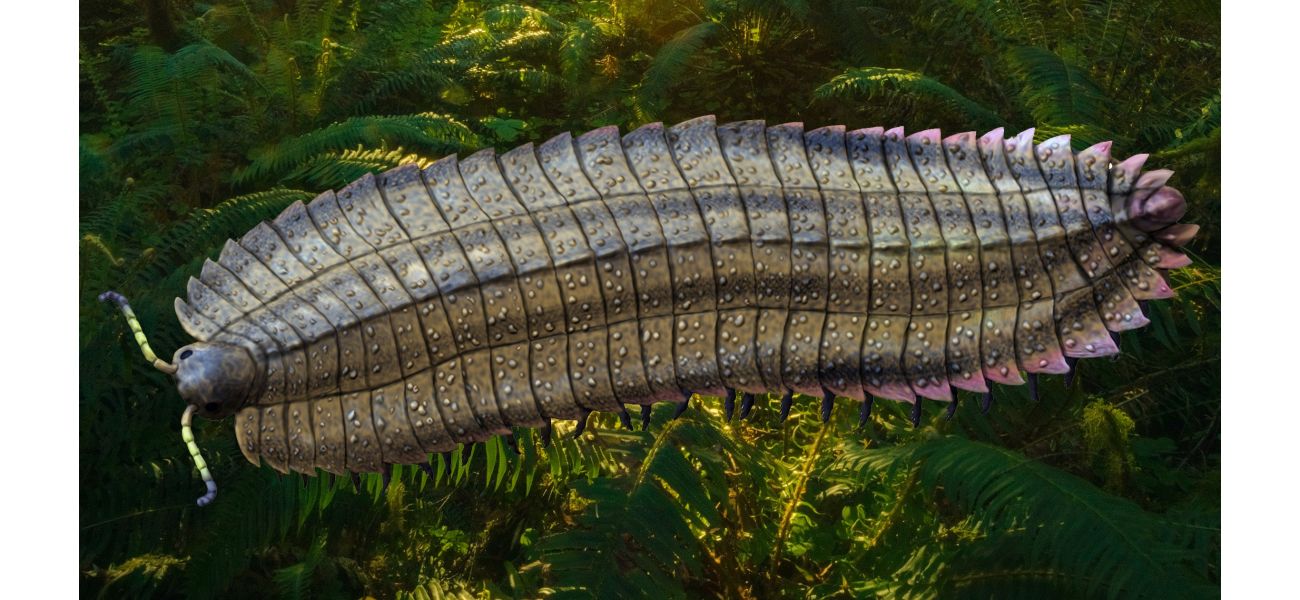Researchers discover giant bug that lived on Earth over 300 million years ago and was the size of a car.
Ancient millipedes were huge, measuring 8.5 feet and weighing 45kg.
October 13th 2024.

Millions of years ago, deep in the forests near the equator, a mysterious creature roamed the earth. This creature, known as the Arthropleura, has long been a subject of fascination for scientists. Recently, however, the discovery of two well-preserved fossils has shed new light on this car-sized mega-millipede.
It is believed that the Arthropleura lived during the late Paleozoic era, between 346 and 290 million years ago. With a massive length of 8.5 feet and a weight of over 45kg, this creature has puzzled paleontologists for decades. Its towering height of 8ft and its diet of vegetation suggest that it resided in the forests, surrounded by lush greenery.
At first glance, the Arthropleura may have resembled a millipede, but its head remained a mystery. Without ever having seen its head before, experts were unable to determine its relationship to modern arthropods. However, the recent discovery of its head has revealed some remarkable features. With a round structure adorned with two short, bell-shaped antennae, it also has two protruding eyes resembling those of crabs and a small mouth for scavenging leaves and bark.
Like other arthropods, the Arthropleura would shed its exoskeleton through an opening on its head. However, the fossilized exoskeletons provided little information about the creature's facial structure. It wasn't until more juvenile fossils were found that experts were finally able to study the head and gain a deeper understanding of this enigmatic creature.
Thanks to advanced CT scanning techniques, researchers were able to model the head and examine the fossils without causing any damage. These fossils, which were taken from a French coal field in the 1980s, were still embedded in rock and required delicate handling. With the addition of these new juvenile fossils, experts were able to piece together the missing parts and learn more about the Arthropleura.
Co-author of the study, Mickael Lheritier, expressed his excitement about their findings, stating, "We discovered that it had the body of a millipede, but the head of a centipede." This unexpected combination of characteristics has only added to the fascination surrounding this ancient creature. Paleobiologist James Lamsdell, who was not involved in the study, expressed his appreciation for the non-invasive scanning techniques used, stating, "When you chip away at rock, you don't know what part of a delicate fossil may have been lost or damaged."
Despite the fossils being only two inches long, the researchers are confident that they provide valuable insights into the nature of the Arthropleura. With its massive size and unique features, this creature continues to captivate scientists and ignite their curiosity. The discovery of its head has opened up a whole new realm of possibilities for further research and understanding of this ancient arthropod.
It is believed that the Arthropleura lived during the late Paleozoic era, between 346 and 290 million years ago. With a massive length of 8.5 feet and a weight of over 45kg, this creature has puzzled paleontologists for decades. Its towering height of 8ft and its diet of vegetation suggest that it resided in the forests, surrounded by lush greenery.
At first glance, the Arthropleura may have resembled a millipede, but its head remained a mystery. Without ever having seen its head before, experts were unable to determine its relationship to modern arthropods. However, the recent discovery of its head has revealed some remarkable features. With a round structure adorned with two short, bell-shaped antennae, it also has two protruding eyes resembling those of crabs and a small mouth for scavenging leaves and bark.
Like other arthropods, the Arthropleura would shed its exoskeleton through an opening on its head. However, the fossilized exoskeletons provided little information about the creature's facial structure. It wasn't until more juvenile fossils were found that experts were finally able to study the head and gain a deeper understanding of this enigmatic creature.
Thanks to advanced CT scanning techniques, researchers were able to model the head and examine the fossils without causing any damage. These fossils, which were taken from a French coal field in the 1980s, were still embedded in rock and required delicate handling. With the addition of these new juvenile fossils, experts were able to piece together the missing parts and learn more about the Arthropleura.
Co-author of the study, Mickael Lheritier, expressed his excitement about their findings, stating, "We discovered that it had the body of a millipede, but the head of a centipede." This unexpected combination of characteristics has only added to the fascination surrounding this ancient creature. Paleobiologist James Lamsdell, who was not involved in the study, expressed his appreciation for the non-invasive scanning techniques used, stating, "When you chip away at rock, you don't know what part of a delicate fossil may have been lost or damaged."
Despite the fossils being only two inches long, the researchers are confident that they provide valuable insights into the nature of the Arthropleura. With its massive size and unique features, this creature continues to captivate scientists and ignite their curiosity. The discovery of its head has opened up a whole new realm of possibilities for further research and understanding of this ancient arthropod.
[This article has been trending online recently and has been generated with AI. Your feed is customized.]
[Generative AI is experimental.]
0
0
Submit Comment





